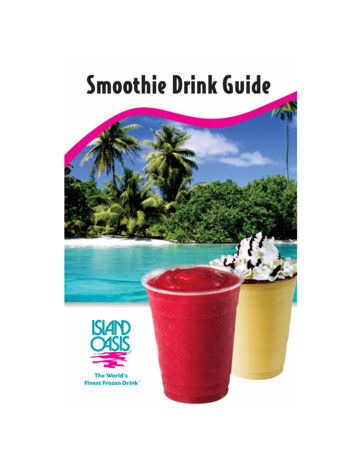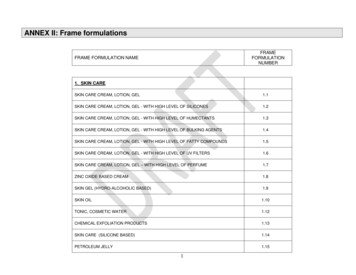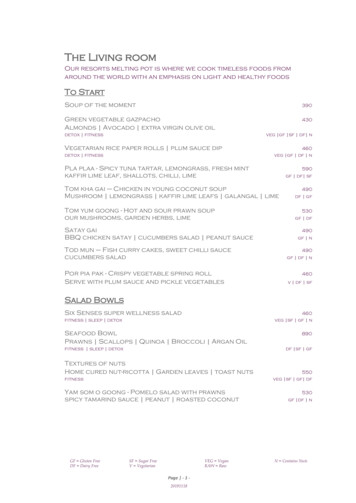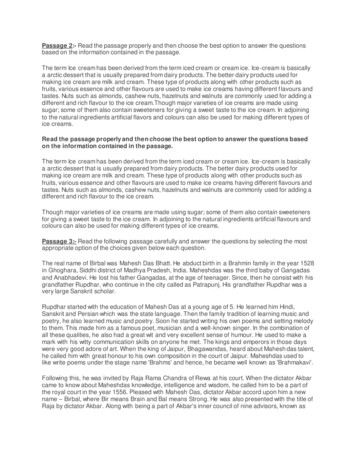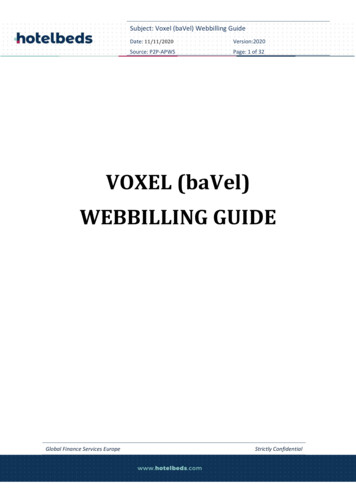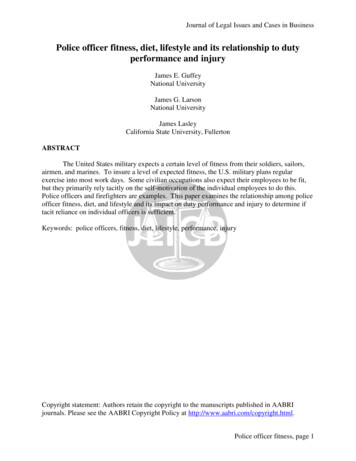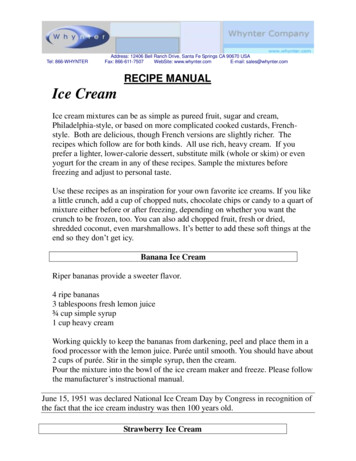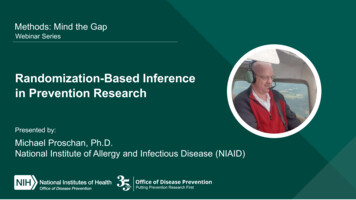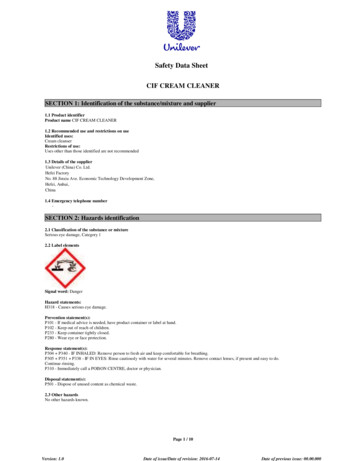
Transcription
Safety Data SheetCIF CREAM CLEANERSECTION 1: Identification of the substance/mixture and supplier1.1 Product identifierProduct name CIF CREAM CLEANER1.2 Recommended use and restrictions on useIdentified uses:Cream cleanserRestrictions of use:Uses other than those identified are not recommended1.3 Details of the supplierUnilever (China) Co. Ltd.Hefei FactoryNo. 88 Jinxiu Ave. Economic Technology Development Zone,Hefei, Anhui,China1.4 Emergency telephone number-SECTION 2: Hazards identification2.1 Classification of the substance or mixtureSerious eye damage, Category 12.2 Label elementsSignal word: DangerHazard statements:H318 - Causes serious eye damage.Prevention statement(s):P101 - If medical advice is needed, have product container or label at hand.P102 - Keep out of reach of children.P233 - Keep container tightly closed.P280 - Wear eye or face protection.Response statement(s):P304 P340 - IF INHALED: Remove person to fresh air and keep comfortable for breathing.P305 P351 P338 - IF IN EYES: Rinse cautiously with water for several minutes. Remove contact lenses, if present and easy to do.Continue rinsing.P310 - Immediately call a POISON CENTRE, doctor or physician.Disposal statement(s):P501 - Dispose of unused content as chemical waste.2.3 Other hazardsNo other hazards known.Page 1 / 10Version: 1.0Date of issue/Date of revision: 2016-07-14Date of previous issue: 00.00.000
SECTION 3: Composition/information on ingredients3.1 Substances / MixturesIngredient(s)sodium alkylbenzenesulphonateCAS number90194-45-9EC number290-656-6sodium carbonateAlcohols, C10-12, ute Tox. 4 (H302)Skin Irrit. 2 (H315)Eye Dam. 1 (H318)Eye Irrit. 2 (H319)STOT SE 3 (H335)Eye Dam. 1 (H318)Acute Tox. 2 (H330)Acute Tox. 4 (H302)Skin Irrit. 2 (H315)Eye Dam. 1 (H318)Skin Sens. 1 (H317)Weight percent3-103-101-30.01-0.1Non-hazardous ingredients are the remainder and add up to 100%.* Polymer.Workplace exposure limit(s), if available, are listed in subsection 8.1.For the full text of the H and AUH phrases mentioned in this Section, see Section 16.SECTION 4: First aid measures4.1 Description of first aid measuresInhalation:Skin contact:Eye contact:Ingestion:Self-protection of first aider:First aid facilities:Remove person to fresh air and keep comfortable for breathing.Wash skin with plenty of lukewarm, gently flowing water. If skin irritation occurs: Get medical adviceor attention.Hold eyelids apart and flush eyes with plenty of lukewarm water for at least 15 minutes. Removecontact lenses, if present and easy to do. Continue rinsing. Immediately call a POISON CENTRE, doctor orphysician.Immediately drink 1 glass of water. Never give anything by mouth to an unconscious person. Getmedical attention or advice if you feel unwell.Consider personal protective equipment as indicated in subsection 8.2.Eyewash facilities should be considered in a workplace where necessary.4.2 Most important symptoms and effects, both acute and delayedInhalation:No known effects or symptoms in normal use.Skin contact:No known effects or symptoms in normal use.Eye contact:Causes severe or permanent damage.Ingestion:No known effects or symptoms in normal use.4.3 Indication of any immediate medical attention and special treatment neededNo information available on clinical testing and medical monitoring. Specific toxicological information on substances, if available, can be found in section11.Poison Information Center:-SECTION 5: Firefighting measures5.1 Extinguishing mediaCarbon dioxide. Dry powder. Water spray jet. Fight larger fires with water spray jet or alcohol-resistant foam.5.2 Special hazards arising from the substance or mixtureNo special hazards known.5.3 Advice for firefightersAs in any fire, wear self contained breathing apparatus and suitable protective clothing including gloves and eye/face protection.5.4 Hazchem codeNone allocatedSECTION 6: Accidental release measures6.1 Personal precautions, protective equipment and emergency procedures Weareye/face protection.6.2 Environmental precautionsDo not allow to enter drainage system, surface or ground water. Dilute with plenty of water.6.3 Methods and material for containment and cleaning upPage 2 / 10Version: 1.0Date of issue/Date of revision: 2016-07-14Date of previous issue: 00.00.000
Absorb with liquid-binding material (sand, diatomite, universal binders, sawdust).6.4 Reference to other sectionsFor personal protective equipment see subsection 8.2. For disposal considerations see section 13.SECTION 7: Handling and storage7.1 Precautions for safe handlingMeasures to prevent fire and explosions:No special precautions required.Measures required to protect the environment:For environmental exposure controls see subsection 8.2.Advices on general occupational hygiene:Handle in accordance with good industrial hygiene and safety practice. Keep away from food, drink and animal feeding stuffs. Keep out of reach ofchildren. Do not mix with other products unless adviced by Unilever. Wash hands before breaks and at the end of workday. Wash face, hands and anyexposed skin thoroughly after handling. Take off immediately all contaminated clothing. Use personal protective equipment as required. Avoid contactwith eyes. Use only with adequate ventilation.7.2 Conditions for safe storage, including any incompatibilitiesStore in accordance with local and national regulations. Keep out of reach of children. Keep only in original container. Store in a closed container.For conditions to avoid see subsection 10.4. For incompatible materials see subsection 10.5.7.3 Specific end use(s)No specific advice for end use available.SECTION 8: Exposure controls/personal protection8.1 Control parametersWorkplace exposure limitsAir limit values, if available:Biological limit values, if available:8.2 Exposure controlsThe following information applies for the uses indicated in subsection 1.2 of the Safety Data Sheet.If available, please refer to the product information sheet for application and handling instructions.Normal use conditions are assumed for this section.Recommended safety measures for handling the undiluted product:Appropriate engineering controls:Appropriate organisational controls:No special requirements under normal use conditions.Avoid direct contact and/or splashes where possible Train personnelPersonal protective equipmentEye / face protection:Hand protection:Body protection:Respiratory protection:Safety glasses or goggles (EN 166).Rinse and dry hands after use. For prolonged contact protection for the skin may be necessary.No special requirements under normal use conditions.No special requirements under normal use conditions.Environmental exposure controls:No special requirements under normal use conditions.SECTION 9: Physical and chemical properties9.1 Information on basic physical and chemical propertiesPhysical State: LiquidAppearance: Viscous liquidColour: Opaque,YellowOdour: Slightly perfumedOdour threshold: Not applicablepH: 10.5 -11.5 (neat)Melting point/freezing point ( C): Not determinedInitial boiling point and boiling range ( C): Not determinedFlash point ( C): Not applicable.Sustained combustion: Not applicable.Evaporation rate: Not determinedPage 3 / 10Version: 1.0Date of issue/Date of revision: 2016-07-14Date of previous issue: 00.00.000
Flammability (solid, gas): Not determinedUpper/lower flammability limit (%): Not determinedVapour pressure: Not determinedVapour density: Not determinedRelative density: 1.55 (approximately) g/cm³ (20 C)Solubility in / Miscibility with Water: Fully miscibleAutoignition temperature: Not determinedDecomposition temperature: Not applicable.Viscosity: Not determinedExplosive properties: Not explosive.Oxidising properties: Not oxidising9.2 Other informationSurface tension (N/m): Not determinedCorrosion to metals: Not corrosiveSECTION 10: Stability and reactivity10.1 ReactivityNo reactivity hazards known under normal storage and use conditions.10.2 Chemical stabilityStable under normal storage and use conditions.10.3 Possibility of hazardous reactionsNo hazardous reactions known under normal storage and use conditions.10.4 Conditions to avoidNone known under normal storage and use conditions.10.5 Incompatible materialsNone known under normal use conditions. Reacts with acids.10.6 Hazardous decomposition productsNone known under normal storage and use conditions.SECTION 11: Toxicological information11.1 Information on toxicological effectsMixture data:.Relevant calculated ATE(s):ATE - Oral (mg/kg): 5000Substance data, where relevant and available, are listed below:.Acute toxicityAcute oral toxicityIngredient(s)Endpointsodium alkylbenzenesulphonatesodium carbonateLD 50Alcohols, C10-12, ethoxylatedValue(mg/kg)No dataavailable2800SpeciesMethodRatMethod not givenSpeciesMethodRabbitMethod not givenSpeciesMethodExposuretime (h)No dataavailableNo dataavailable1,2-benzisothiazol-3(2H)-oneAcute dermal toxicityIngredient(s)Endpointsodium alkylbenzenesulphonatesodium carbonateLD 50Alcohols, C10-12, ethoxylatedValue(mg/kg)No dataavailable 2000Exposuretime (h)No dataavailableNo dataavailable1,2-benzisothiazol-3(2H)-oneAcute inhalative toxicityIngredient(s)EndpointValueExposurePage 4 / 10Version: 1.0Date of issue/Date of revision: 2016-07-14Date of previous issue: 00.00.000
(mg/l)No dataavailable2.3 (dust)No dataavailableNo dataavailablesodium alkylbenzenesulphonatesodium carbonateAlcohols, C10-12, ethoxylatedLC 501,2-benzisothiazol-3(2H)-onetime (h)RatOECD 403 (EU B.2)2Irritation and corrosivitySkin irritation and corrosivityIngredient(s)sodium alkylbenzenesulphonateResultNo data availableSpeciesMethodExposure timeRabbitMethod not givensodium carbonateNot irritantAlcohols, C10-12, ethoxylatedNo data available1,2-benzisothiazol-3(2H)-oneNo data availableIngredient(s)sodium alkylbenzenesulphonateResultNo data availableSpeciesMethodRabbitMethod not givenSpeciesMethodExposure timeMethodExposure time (h)Eye irritation and corrosivitysodium carbonateIrritantAlcohols, C10-12, ethoxylatedNo data available1,2-benzisothiazol-3(2H)-oneNo data availableRespiratory tract irritation and corrosivityIngredient(s)sodium alkylbenzenesulphonateResultNo data availablesodium carbonateNo data availableAlcohols, C10-12, ethoxylatedNo data available1,2-benzisothiazol-3(2H)-oneNo data availableIngredient(s)sodium alkylbenzenesulphonateResultNo data availableExposure timeSensitisationSensitisation by skin contactsodium carbonateNot sensitisingAlcohols, C10-12, ethoxylatedNo data available1,2-benzisothiazol-3(2H)-oneNo data availableIngredient(s)sodium alkylbenzenesulphonateResultNo data availableSpeciesMethod not givenSensitisation by inhalationsodium carbonateNo data availableAlcohols, C10-12, ethoxylatedNo data available1,2-benzisothiazol-3(2H)-oneNo data availableSpeciesMethodExposure timeCMR effects (carcinogenicity, mutagenicity and toxicity for reproduction)MutagenicityIngredient(s)Result (in-vitro)Method(in-vitro)Result (in-vivo)sodium alkylbenzenesulphonateNo data availableNo data availablesodium carbonateNo data availableNo data availableAlcohols, C10-12, ethoxylatedNo data availableNo data available1,2-benzisothiazol-3(2H)-oneNo data availableNo data s)sodium alkylbenzenesulphonatesodium carbonateAlcohols, C10-12, ethoxylated1,2-benzisothiazol-3(2H)-oneToxicity for atesodium carbonateAlcohols, C10-12,EndpointEffectNo data availableNo evidence for carcinogenicity, weight-of-evidenceNo data availableNo data availableSpecific effectValue(mg/kg bw/d)No dataavailableSpeciesMethodExposuretimeRemarks and other effectsreportedNo dataavailableNo dataPage 5 / 10Version: 1.0Date of issue/Date of revision: 2016-07-14Date of previous issue: 00.00.000
ethoxylated1,2-benzisothiazol-3(2H)-oneavailableNo dataavailableRepeated dose toxicitySub-acute or sub-chronic oral toxicityIngredient(s)EndpointValue(mg/kg bw/d)No dataavailableNo dataavailableNo dataavailableNo dataavailableSpeciesMethodExposuretime (days)Specific effects and organsaffectedEndpointValue(mg/kg bw/d)No dataavailableNo dataavailableNo dataavailableNo dataavailableSpeciesMethodExposuretime (days)Specific effects and organsaffectedEndpointValue(mg/kg bw/d)No dataavailableNo dataavailableNo dataavailableNo dataavailableSpeciesMethodExposuretime (days)Specific effects and organsaffectedsodium alkylbenzenesulphonatesodium carbonateAlcohols, C10-12, ethoxylated1,2-benzisothiazol-3(2H)-oneSub-chronic dermal toxicityIngredient(s)sodium alkylbenzenesulphonatesodium carbonateAlcohols, C10-12, ethoxylated1,2-benzisothiazol-3(2H)-oneSub-chronic inhalation toxicityIngredient(s)sodium alkylbenzenesulphonatesodium carbonateAlcohols, C10-12, ethoxylated1,2-benzisothiazol-3(2H)-oneChronic odium carbonateAlcohols, surerouteEndpointValue(mg/kg bw/d)No dataavailableSpeciesMethodExposuretimeSpecific effects andorgans affectedRemarkNo dataavailableNo dataavailableNo dataavailableSTOT-single exposureIngredient(s)sodium alkylbenzenesulphonatesodium carbonateAlcohols, C10-12, ethoxylated1,2-benzisothiazol-3(2H)-oneAffected organ(s)No data availableNo data availableNo data availableNo data availableIngredient(s)sodium alkylbenzenesulphonatesodium carbonateAlcohols, C10-12, ethoxylated1,2-benzisothiazol-3(2H)-oneAffected organ(s)No data availableNo data availableNo data availableNo data availableSTOT-repeated exposureAspiration hazardSubstances with an aspiration hazard (H304), if any, are listed in section 3. If relevant, see section 9 for dynamic viscosit y and relative density of theproduct.Potential adverse health effects and symptomsEffects and symptoms related to the product, if any, are listed in subsection 4.2.SECTION 12: Ecological information12.1 ToxicityPage 6 / 10Version: 1.0Date of issue/Date of revision: 2016-07-14Date of previous issue: 00.00.000
No data is available on the mixture.Substance data, where relevant and available, are listed below:Aquatic short-term toxicityAquatic short-term toxicity - fishIngredient(s)Endpointsodium alkylbenzenesulphonatesodium carbonateLC 50Alcohols, C10-12, ethoxylatedValue(mg/l)No dataavailable300SpeciesMethodExposuretime (h)LepomismacrochirusMethod not given96SpeciesMethodExposuretime (h)Daphniamagna StrausMethod not given96Value(mg/l)No dataavailableNo dataavailableNo dataavailableNo dataavailableSpeciesMethodExposuretime (h)Value(mg/l)No dataavailableNo dataavailableNo dataavailableNo dataavailableSpeciesValue(mg/l)No dataavailableNo dataavailableNo dataavailableNo dataavailableInoculumNo dataavailableNo dataavailable1,2-benzisothiazol-3(2H)-oneAquatic short-term toxicity - crustaceaIngredient(s)Endpointsodium alkylbenzenesulphonatesodium carbonateEC 50Alcohols, C10-12, ethoxylatedValue(mg/l)No dataavailable265No dataavailableNo dataavailable1,2-benzisothiazol-3(2H)-oneAquatic short-term toxicity - algaeIngredient(s)Endpointsodium alkylbenzenesulphonatesodium carbonateAlcohols, C10-12, ethoxylated1,2-benzisothiazol-3(2H)-oneAquatic short-term toxicity - marine speciesIngredient(s)Endpointsodium alkylbenzenesulphonatesodium carbonateAlcohols, C10-12, ethoxylated1,2-benzisothiazol-3(2H)-oneImpact on sewage plants - toxicity to bacteriaIngredient(s)Endpointsodium alkylbenzenesulphonatesodium carbonateAlcohols, C10-12, suretime (days)-MethodExposuretimeAquatic long-term toxicityAquatic long-term toxicity - fishIngredient(s)EndpointValue(mg/l)No dataavailableNo dataavailableNo dataavailableNo dataavailableSpeciesMethodExposuretimeEffects observedEndpointValueSpeciesMethodExposureEffects observedsodium alkylbenzenesulphonatesodium carbonateAlcohols, C10-12, ethoxylated1,2-benzisothiazol-3(2H)-oneAquatic long-term toxicity - crustaceaIngredient(s)Page 7 / 10Version: 1.0Date of issue/Date of revision: 2016-07-14Date of previous issue: 00.00.000
(mg/l)No dataavailableNo dataavailableNo dataavailableNo dataavailablesodium alkylbenzenesulphonatesodium carbonateAlcohols, C10-12, ethoxylated1,2-benzisothiazol-3(2H)-onetimeAquatic toxicity to other aquatic benthic organisms, including sediment-dwelling organisms, if available:Ingredient(s)EndpointValueSpecies(mg/kg dwsediment)sodium alkylbenzenesulphonateNo dataavailablesodium carbonateNo dataavailableAlcohols, C10-12, ethoxylatedNo dataavailable1,2-benzisothiazol-3(2H)-oneNo dataavailableMethodExposuretime (days)Effects observed-Terrestrial toxicityTerrestrial toxicity - soil invertebrates, including earthworms, if available:Ingredient(s)Endpointsodium carbonateTerrestrial toxicity - plants, if available:Ingredient(s)Endpointsodium carbonateTerrestrial toxicity - birds, if available:Ingredient(s)Endpointsodium carbonateValue(mg/kg dwsoil)No dataavailableSpeciesMethodEndpointsodium carbonateTerrestrial toxicity - soil bacteria, if available:Ingredient(s)Endpointsodium carbonateEffects observedValue(mg/kg dwsoil)No dataavailableSpeciesValueSpeciesMethodExposuretime (days)-Effects observedValue(mg/kg dwsoil)No dataavailableSpeciesMethodExposuretime (days)Effects observedValue(mg/kg dwsoil)No dataavailableSpecies-MethodExposuretime (days)Effects observed-No dataavailableTerrestrial toxicity - beneficial insects, if available:Ingredient(s)Exposuretime (days)-MethodExposuretime (days)Effects observed-12.2 Persistence and degradabilityAbiotic degradationAbiotic degradation - photodegradation in air, if available:Abiotic degradation - hydrolysis, if available:Ingredient(s)sodium carbonateHalf-life time in freshwaterNo data availableMethodEvaluationRemarkRapidly hydrolysibleAbiotic degradation - other processes, if available:BiodegradationReady biodegradability - aerobic conditionsIngredient(s)InoculumAnalyticalmethodDT 50sodium alkylbenzenesulphonateMethodEvaluationNo data availablesodium carbonateAlcohols, C10-12, ethoxylatedNot applicable (inorganicsubstance)No data available1,2-benzisothiazol-3(2H)-oneReadily biodegradablePage 8 / 10Version: 1.0Date of issue/Date of revision: 2016-07-14Date of previous issue: 00.00.000
Ready biodegradability - anaerobic and marine conditions, if available:Degradation in relevant environmental compartments, if available:12.3 Bioaccumulative potentialPartition coefficient n-octanol/water (log Kow)Ingredient(s)Valuesodium alkylbenzenesulphonateNo data availablesodium carbonateNo data availableAlcohols, C10-12, ethoxylatedNo data available1,2-benzisothiazol-3(2H)-oneNo data availableBioconcentration factor (BCF)Ingredient(s)ValuesodiumNo data availablealkylbenzenesulphonatesodium carbonateNo data availableAlcohols, odSpeciesEvaluationRemarkNo bioaccumulation expectedMethodEvaluationRemarkNo bioaccumulation expectedNo data availableNo data available12.4 Mobility in soilAdsorption/Desorption to soil or sedimentIngredient(s)sodium alkylbenzenesulphonateAdsorptioncoefficientLog KocNo data availablesodium carbonateNo data availableAlcohols, C10-12, ethoxylatedNo data available1,2-benzisothiazol-3(2H)-oneNo data availableDesorptioncoefficientLog Koc(des)MethodSoil/sedimenttypeEvaluationPotential for mobility in soil,soluble in water12.5 Other adverse effectsNo other adverse effects known.SECTION 13: Disposal considerations13.1 Waste treatment methodsWaste from residues / unusedproducts:Empty packagingRecommendation: Suitablecleaning agents:The concentrated contents or contaminated packaging should be disposed of by a certified handler oraccording to the site permit. Release of waste to sewers is discouraged. The cleaned packaging material issuitable for energy recovery or recycling in line with local legislation.Dispose of observing national or local regulations.Water, if necessary with cleaning agent.SECTION 14: Transport informationADG, IMO/IMDG, ICAO/IATA14.1 UN number: Non-dangerous goods14.2 UN proper shipping name: Non-dangerous goods14.3 Transport hazard class(es): Non-dangerous goods14.4 Packing group: Non-dangerous goods14.5 Environmental hazards: Non-dangerous goods14.6 Special precautions for user: Non-dangerous goods14.7 Transport in bulk according to Annex II of MARPOL 73/78 and the IBC Code: The product is not transported in bulk tankers.Hazchem code: None allocatedSECTION 15: Regulatory information15.1 Safety, health and environmental regulations/legislation specific for the substance or mixtureNational regulations:Globally Harmonised System of Classification and Labelling of Chemicals (GHS) as published bySafework Australia.Poison scheduleA poison schedule number has not been allocated to this product using the criteria in the Standardfor the Uniform Scheduling of Medicines and Poisons (SUSMP).Page 9 / 10Version: 1.0Date of issue/Date of revision: 2016-07-14Date of previous issue: 00.00.000
ClassificationGlobally Harmonised System of Classification and Labelling of Chemicals (GHS) as published bySafework Australia.Inventory listing(s)AICS (Australian Inventory of Chemical Substances): All components are listed on AICS, or areexemptSECTION 16: Other informationThe information in this document is based on our best present knowledge. However, it does not constitute a guarantee for any specific product features anddoes not establish a legally binding contractFull text of the H phrases mentioned in section 3:Respirators: In general the use of respirators should be limited and engineering controls employed to avoid exposure. If respiratory equip ment must be wornensure correct respirator selection and training is undertaken. Remember that some respirators may be extremely uncomfortable when used for long periods.The use of air powered or air supplied respirators should be considered where prolonged or repeated use is necessary.Work practices - solvents: Organic solvents may present both a health and flammability hazard. It is recommended that engineering controls should beadopted to reduce exposure where practicable (for example, if using indoors, ensure explosion proof extraction ventilation is available). Flammable orcombustible liquids with explosive limits have the potential for ignition from static discharge. Refer to AS 1020 (The control of undesirable static electricity)and AS 1940 (The storage and handling of flammable and combustible liquids) for control procedures.Personal protective equipment guidelines: The recommendation for protective equipment contained within this report is provided as a guide only. Factorssuch as method of application, working environment, quantity used, product concentration and the availability of engineering controls should be consideredbefore final selection of personal protective equipment is made.Health effects from exposure: It should be noted that the effects from exposure to this product will depend on several factors including: frequency andduration of use; quantity used; effectiveness of control measures; protective equipment used and method of application. Given that it is impractical toprepare a Safety Data Sheet which would encompass all possible scenarios, it is anticipated that users will assess the risks and apply control methods whereappropriate.End of Safety Data SheetPage 10 / 10Version: 1.0Date of issue/Date of revision: 2016-07-14Date of previous issue: 00.00.000
Version: 1.0 Date of issue/Date of revision: 2016-07-14 Date of previous issue: 00.00.000 Flammability (solid, gas): Not determined Upper/lower flammability limit (%): Not determined Vapour pressure: Not determined Vapour density: Not determined Relative density: 1.55 (approximately) g/cm³ (20 C) Solubility in / Miscibility with Water: Fully miscible
